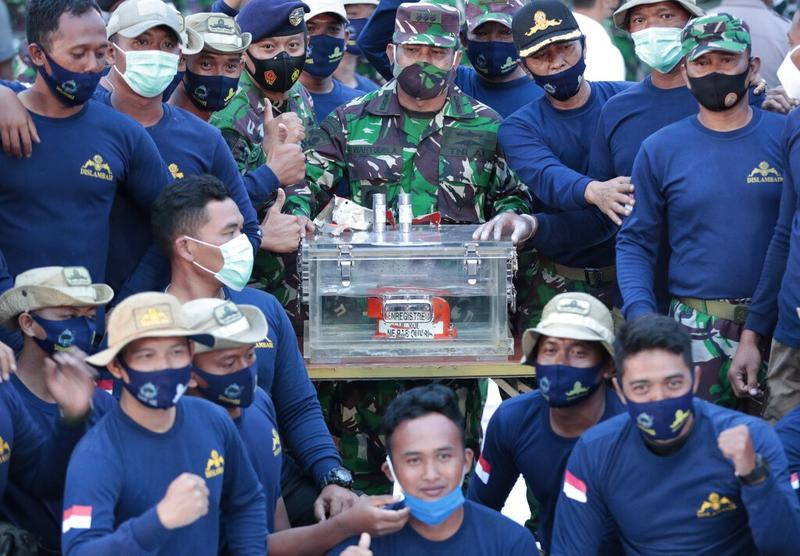 Indonesian Navy personnel pose for photos with the flight data recorder recovered from the wreckage of Sriwijaya Air flight SJ-182 in the Java Sea at Tanjung Priok Port, Indonesia, Jan 12, 2021. (DITA ALANGKARA / AP)
Indonesian Navy personnel pose for photos with the flight data recorder recovered from the wreckage of Sriwijaya Air flight SJ-182 in the Java Sea at Tanjung Priok Port, Indonesia, Jan 12, 2021. (DITA ALANGKARA / AP)
JAKARTA - Indonesian divers on Tuesday retrieved from the sea bed the flight data recorder (FDR) of a Sriwijaya Air plane that crashed into the Java Sea with 62 people on board at the weekend, officials said.
Divers had also found a separate radio beacon, raising hopes that the cockpit voice recorder (CVR) it was connected to could soon be found and reveal what caused the plane to lose control moments after takeoff.
“We are sure that, because the beacon that was attached to the cockpit voice recorder was also found around the area, so with high confidence, the cockpit voice recorder will soon be found,” military chief Hadi Tjahjanto said at a news conference.
The National Transportation Safety Committee (KNKT) expects to download the flight data recorder's data within two to five days, military chief Hadi Tjahjanto said
With few immediate clues on what happened after takeoff, investigators will rely heavily on the flight recorders to determine what went wrong.
The National Transportation Safety Committee (KNKT) expects to download the FDR data within two to five days, its chief Soerjanto Tjahjono said.
“Hopefully we will be able to unveil the mystery of what caused this accident ... so this becomes a lesson for all of us to avoid this in the future,” Soerjanto said.
The Boeing 737-500 plane plunged into the Java Sea on Saturday, four minutes after taking off from Jakarta’s main airport.
The KNKT’s initial findings showed the plane’s engine was running when it hit the water, based on jet parts retrieved from the sea.
“The damage on the fan blade showed that the engine was still working on impact. This is consistent with the hypothesis that the plane’s system was still working at 250 feet altitude,” Soerjanto said.
 Indonesian Navy divers position their boats near marker buoys as they continue the search for the wreckage of the crashed Sriwijaya Air passenger jet in the Java Sea, near Jakarta, Indonesia, Jan 12, 2021. (TATAN SYUFLANA / AP)
Indonesian Navy divers position their boats near marker buoys as they continue the search for the wreckage of the crashed Sriwijaya Air passenger jet in the Java Sea, near Jakarta, Indonesia, Jan 12, 2021. (TATAN SYUFLANA / AP)
“Today we are focusing on finding the victims,” Yusuf Latif, a spokesman for search and rescue agency Basarnas, said.
Unmanned vehicle
Indonesia has deployed a remotely operated underwater vehicle to help divers search for the remains of victims.
Indonesian police made the first identification of a victim from the crash on Monday. Flight attendant Okky Bisma was identified by his fingerprints, said a police official.
“My super kind husband... Heaven is your place... Until we meet again darling,” Okky’s wife, who is also a flight attendant, wrote on her Instagram account.
The Boeing 737-500 jet was headed on a domestic flight to Pontianak on Borneo island, about 740 kilometers from Jakarta, before it disappeared from radar screens.
 Police officers carry a part of aircraft recovered from Java Sea where a Sriwijaya Air passenger jet crashed, at Tanjung Priok Port in Jakarta, Indonesia, Jan 11, 2021. (PHOTO / AFP)
Police officers carry a part of aircraft recovered from Java Sea where a Sriwijaya Air passenger jet crashed, at Tanjung Priok Port in Jakarta, Indonesia, Jan 11, 2021. (PHOTO / AFP)
It was the second major air crash in Indonesia since 189 passengers and crew were killed in 2018 when a Lion Air Boeing 737 MAX also plunged into the Java Sea soon after taking off. The jet that crashed on Saturday is a largely different design.
READ MORE: Indonesia's aviation safety under fresh spotlight after plane crash
Indonesia’s transport ministry said earlier on Tuesday the jet, which was grounded during the early months of the coronavirus pandemic, had passed an airworthiness inspection on Dec 14 and had returned to service shortly after.
The Sriwijaya Air plane was nearly 27 years old, much older than Boeing’s problem-plagued 737 MAX model.
Older 737 models are widely flown and do not have the stall-prevention system implicated in the MAX safety crisis.


